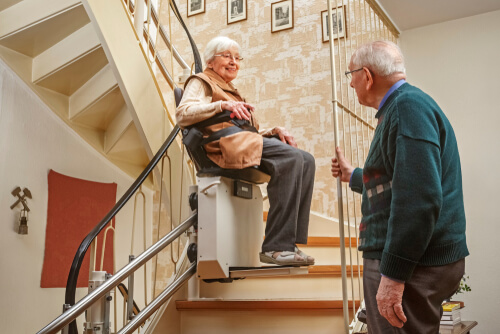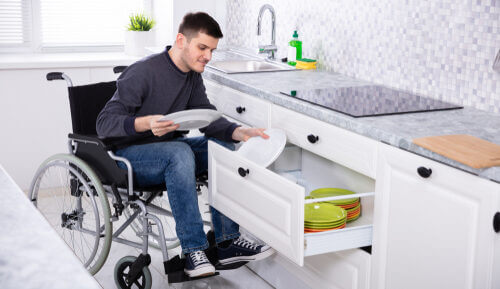
Page contents
- What home adaptations can I get?
- How much are home adaptations?
- What are the benefits of home adaptations?
- How do I get a home assessment from my local council?
- How do I get help with the costs of home adaptations?
- What is the Disabled Facilities Grant (DFG)?
- How much is the Disabled Facilities Grant?
- Independence at Home
- How can home improvement agencies help?
Page contents
- What home adaptations can I get?
- How much are home adaptations?
- What are the benefits of home adaptations?
- How do I get a home assessment from my local council?
- How do I get help with the costs of home adaptations?
- What is the Disabled Facilities Grant (DFG)?
- How much is the Disabled Facilities Grant?
- Independence at Home
- How can home improvement agencies help?
Home adaptations such as a stairlift or grabrails can help older or disabled people to better manage life at home and avoid moving to a new house or going into a care home.
Adaptations to your house could be improvements such as making your house wheelchair accessible by widening doorways or putting in ramps. They can also be small adaptations such as installing a grab rail to help you get out of the bath.
What home adaptations can I get?
Adaptations can help you get up and down the stairs and use the bathroom and toilet. They can make rooms wheelchair accessible and help you to use kitchen equipment safely.
Home adaptations can include:
- Fitting a stairlift or banister
- Adding grab rails to the bath or by the bed
- Adding a bath lift
- Installing a walk-in shower or bath
- Fitting a wet room
- Installing an outdoor ramp or step rail
- Installing motion sensor lights at your front door
- Lowering kitchen tops
- Widening doorways
How much are home adaptations?
There is a wide range of home improvements available. They can be big or small depending on your needs. Some housing adaptations may be expensive and require building work. But you may be able to receive grants to help with the costs.
You should be able to get minor adaptations to your house for free as your local council should be able to cover the costs of adaptations below £1,000.
What are the benefits of home adaptations?
Making adaptations to your home instead of paying for care can turn out to be a cost-effective solution long term.
- It can also allow you to continue living in the comfort of your own home even if you are in later life or have a disability.
- Improvements to your home such as lowering the kitchen worktops can make it a lot easier to prepare meals. While fitting grab rails can help you avoid falls and injuries.
- If you are in a wheelchair, adapting your house by adding access ramps, widening doors and lowering or raising tables will help you move around the home safely.
- Making changes to your home can be greatly beneficial to accessibility and independence in day-to-day living.
How do I get a home assessment from my local council?
There are lots of options of adaptations available. Your local authority can help you figure out what adaptations would work the best for you through a home assessment. The assessment will also determine whether you have to pay for the adaptations yourself or if you can get help with the costs.
A home assessment from your local authority’s social services is free. It looks at your house and recommends what changes could help you live as comfortably and independently as possible.
To ensure any potential changes to your home are tailored to your individual needs, an occupational therapist will visit your house to make the assessment. This will generally last an hour.
During the assessment, you will be asked questions about your circumstances, how you manage life at home and any difficulties you have with everyday tasks.
It is vital that you are completely honest in your responses. As the more the occupational therapist knows about you and your struggles, the better they will be able to understand what adaptations should be made.
To request a home assessment, contact your local council by phone or you can start the process online.
In addition to having a home assessment, it is advisable to request a free needs assessment from your local council. This will help you see if you can benefit from extra care or help at home, what support you are entitled to and how the council can help you with costs.
You have the right to request a needs assessment at any time and you could do this before your home assessment.
How do I get help with the costs of home adaptations?
Depending on if the changes you are making to your home are small or large, you may not have to pay for them yourself.
Whether you need to cover the costs yourself should be clear after the needs assessment and home assessment as they have a duty to offer support if your needs are eligible.
For example, if specialist disability equipment is recommended by the social worker or occupational therapist who visited you for the assessments, you will be provided with this for free.
Your local council should pay for minor home adaptations if they cost less than £1,000, such as grabrails, outside lights and ramps.
Larger home adaptations that require building work, such as fitting a wet room, will be more expensive and the council will not be able to pay for it. However, there are other ways to get help with costs from grants, charities or a home improvement agency.
What is the Disabled Facilities Grant (DFG)?
The Disabled Facilities Grant is a grant offered by local authorities to help a disabled person to make large modifications to their home. It is available to people over the age of 18 with any permanent disability, including physical and learning disabilities as well as mental illness.
Home adaptations for disabled people can include widening doors, installing ramps, provide a heating system and more to make disabled living easier to manage.
How much is the Disabled Facilities Grant?
DFG is means-tested, so the amount you can get depends on your household income and savings. As each local authority has its own criteria for the means test, contact them for specific information.
- In England, you could get up to £30,000
- In Wales, you may get as much as £36,000
- In Northern Ireland, £25,000 is the upper limit
In Scotland, the Scheme of Assistance is used instead and the amount available depends on the local authority.
To apply for a Disabled Facilities Grant if you live in England or Wales, click here.
If you live in Northern Ireland, the grant is managed by the Northern Ireland Housing Executive (NIHE). You need to apply through your local Health and Social Services Trust.
For people in Scotland, visit the government’s guide to funding major adaptations for more information.
Be aware that a grant application can take some time, particularly if you need to apply for planning permission.
Independence at Home
Independence at Home is a charity which has helped improve the independence, comfort, safety and quality of life of people with long-term illness and disability.
If you need help with the cost of large home adaptations, Independence at Home may be able to provide financial support.
To be eligible for a grant, you must be unable to afford to pay for the adaptations yourself or unable to receive the funding from statutory services.
You must also be referred to Independence at Home by a professional health and social care worker or a charity.
How can home improvement agencies help?
Another option is to contact a Home Improvement Agency (HIA). They can help you find schemes to cover the costs of home adaptations. Visit the Home Improvement Agencies website to find out if there are any agencies in your area.
For other ways to get help with care costs, read our advice on paying for care at home.


